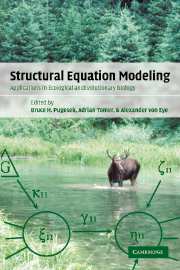Book contents
- Frontmatter
- Contents
- List of contributors
- Preface
- Section 1 Theory
- Section 2 Applications
- 6 Modeling intraindividual variability and change in bio-behavioral developmental processes
- 7 Examining the relationship between environmental variables and ordination axes using latent variables and structural equation modeling
- 8 From biological hypotheses to structural equation models: the imperfection of causal translation
- 9 Analyzing dynamic systems: a comparison of structural equation modeling and system dynamics modeling
- 10 Estimating analysis of variance models as structural equation models
- 11 Comparing groups using structural equations
- 12 Modeling means in latent variable models of natural selection
- 13 Modeling manifest variables in longitudinal designs – a two-stage approach
- Section 3 Computing
- Index
13 - Modeling manifest variables in longitudinal designs – a two-stage approach
Published online by Cambridge University Press: 14 October 2009
- Frontmatter
- Contents
- List of contributors
- Preface
- Section 1 Theory
- Section 2 Applications
- 6 Modeling intraindividual variability and change in bio-behavioral developmental processes
- 7 Examining the relationship between environmental variables and ordination axes using latent variables and structural equation modeling
- 8 From biological hypotheses to structural equation models: the imperfection of causal translation
- 9 Analyzing dynamic systems: a comparison of structural equation modeling and system dynamics modeling
- 10 Estimating analysis of variance models as structural equation models
- 11 Comparing groups using structural equations
- 12 Modeling means in latent variable models of natural selection
- 13 Modeling manifest variables in longitudinal designs – a two-stage approach
- Section 3 Computing
- Index
Summary
Abstract
Increasingly, the analysis of biological data involves collection of data over time, especially when the phenomena of interest concern identification of patterns of differential growth or response to long-term environmental stressors. When different patterns over time can be identified, they may indicate the presence of different survival strategies in a population of interest, species-specific responses to stressors, or may be markers for as yet unidentified subspecies in the population. In this chapter, two techniques for the analysis of biological data over time are described. The first technique is a two-stage analysis of data over time in which polynomial regressions are conducted to identify distinct growth patterns in the data. These growth curve patterns are then used in subsequent structural models to identify the correlates of growth curves. The second technique, the method of “Tuckerized” growth curves, proposes identification of growth curves by an eigenvalue decomposition. This solution is then rotated to make the solution conceptually interpretable within the context of overall growth over time. Factor scores from this rotated solution are then used to investigate whether such growth patterns differ as a function of environmental or species classification. Both techniques are compared and contrasted using longitudinal data on tree circumference taken from three species of trees located in the wetlands of two North American states, South Carolina and Louisiana. Rather than being competing models of growth over time, these two techniques represent complementary analyses, which differ in terms of their assumptions of categorization and growth curve processes over time.
- Type
- Chapter
- Information
- Structural Equation ModelingApplications in Ecological and Evolutionary Biology, pp. 312 - 352Publisher: Cambridge University PressPrint publication year: 2003



